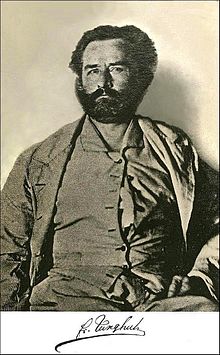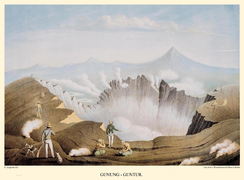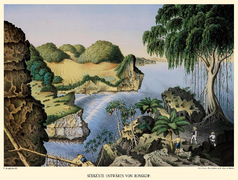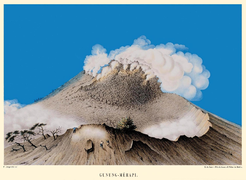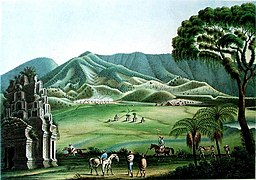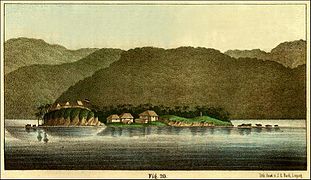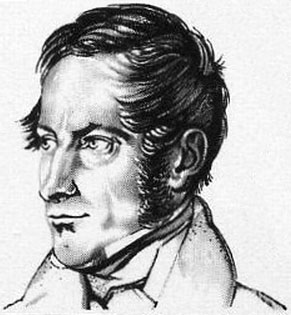
Philipp Franz Balthasar von Siebold was a German physician, botanist and traveller. He achieved prominence by his studies of Japanese flora and fauna and the introduction of Western medicine in Japan. He was the father of the first female Japanese doctor educated in Western medicine, Kusumoto Ine.

Bandung is the capital city of the West Java province of Indonesia. Located on the island of Java, Greater Bandung is the country's second-largest and second most populous metropolitan area, with over 11 million inhabitants. Situated 768 meters above sea level, approximately 140 kilometres southeast of Jakarta, Bandung has cooler year-round temperatures than most other Indonesian cities. The city lies in a river basin surrounded by volcanic mountains that provide a natural defense system, which was the primary reason for the Dutch East Indies government's plan to move the capital from Batavia to Bandung.

Ujung Kulon National Park is a national park at the westernmost tip of Java, located in Sumur District of Pandeglang Regency, part of Banten province in Indonesia. It once included the volcanic island group of Krakatoa in Lampung province, although current maps has suggested the Krakatoa island group as its own protected area, the Pulau Anak Krakatau Marine Nature Reserve.

Pieter Bleeker was a Dutch medical doctor, ichthyologist, and herpetologist. He was famous for the Atlas Ichthyologique des Indes Orientales Néêrlandaises, his monumental work on the fishes of East Asia published between 1862 and 1877.
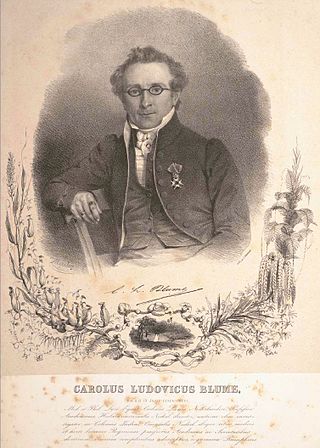
Charles Ludwig de Blume or Karl Ludwig von Blume was a German-Dutch botanist. The standard author abbreviation Blume is used to indicate this person as the author when citing a botanical name.
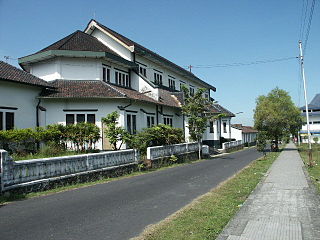
Muntilan is a district (kecamatan) in the Magelang Regency, Central Java. Muntilan is about 15 km south of Magelang, 10 km from Mungkid, 25 km north of Yogyakarta, and 90 km from the main town of Semarang located on the northern coast of Java. The town of Muntilan is on the old railway route between Kebon Polo station in Magelang and the main Tugu station in Yogyakarta. Tourists on their way to the well-known Buddhist temple Borobudur usually pass through Muntilan.

Nepenthes ovata is a tropical pitcher plant endemic to Sumatra. The specific epithet ovata is Latin for "ovate" and refers to the shape of the lower pitchers.

Nepenthes junghuhnii is a tropical pitcher plant native to Sumatra. This species has been the source of much confusion since its discovery. The taxon originally named N. junghuhnii by John Muirhead Macfarlane has never been formally published. In 1994, taxonomist Jan Schlauer described N. junghuhnii as a "rather dubious species based on insufficient specimens". Nepenthes junghuhniisensu Macfarlane has not been relocated in the wild since the collection of the type specimen. It is characterised by strongly petiolate leaves and appears to be most closely related to N. bongso and N. spathulata; Schlauer considers it a possible synonym of the former.
Bandung is a city in the western part of Java island in Indonesia. Beside its own city administration, Bandung also serves as the capital of the West Java province.

Albert Frederik Aalbers is a Dutch architect who created elegant villas, hotels, and office buildings in Bandung, Indonesia, during Dutch colonial rule in the 1930s. Albert Aalbers worked in the Netherlands between 1924 and 1930 and then migrated to the Dutch East Indies, after which he returned to the Netherlands in 1942 due to World War II and political circumstances following Indonesian independence. During his stay in Bandung, in a period when the city was dubbed the city of architecture laboratory, a number of his buildings were considered architectural masterpieces. Aalbers' style was inspired by expressionist Frank Lloyd Wright and modernist Le Corbusier. In Bandung, the DENIS bank in Braga Street and the Savoy Homann Hotel in Asia-Afrika Street, still carry Aalber's ocean wave ornamentation.

Johannes Elias Teijsmann was a biologist, botanist and plant collector. He was born in Arnhem, The Netherlands. His surname is sometimes spelled Teysmann, although he spelled it Teijsmann.
Johannes (Hans) Gottfried Hallier was a German botanist born in Jena.

Adolphe Guillaume Vorderman was a Dutch physician and scientist whose study of the link between polished rice and beriberi in the Dutch East Indies in 1897 helped lead to the discovery of vitamins. In addition, he was an ornithologist and botanist. His great-granddaughter is British television presenter Carol Vorderman.

Willem Hendrik de Vriese was a Dutch botanist and physician born in Oosterhout, North Brabant.

Karel Albert Rudolf Bosscha, sometimes known as KAR Bosscha or Ru Bosscha was a planter, philanthropist and administrator of the Malabar Plantation in Bandung, Indonesia.

Justus Carl Hasskarl was a German explorer and botanist specializing in pteridophytes, bryophytes and spermatophytes.

Kawah Putih is a crater lake and tourist spot in a volcanic crater about 50 kilometres (31 mi) south of Bandung, West Java, Indonesia.

Lake Bandung was a prehistoric lake located in and around the city of Bandung, Parahyangan highlands, West Java, Indonesia. believed to exist between 126,000 and 20,000 BCE in the Pleistocene due to the violent eruption of Mount Sunda that blocked the Citarum River, causing the lowlands to begin to be inundated with water, eventually forming a lake.

Cornelis Andries Backer (1874–1963) was a Dutch botanist and pteridologist. He was born on 18 September 1874 in Oudenbosch and died on 22 February 1963 at Heemstede, The Netherlands. He stayed thirty years in the Dutch East Indies and did research on plant taxonomy on the islands of Java and Madura.
Jacob Jonas Ochse was a Dutch horticulturalist, agronomist, plant collector, and botanist, specializing in tropical and subtropical botany.
